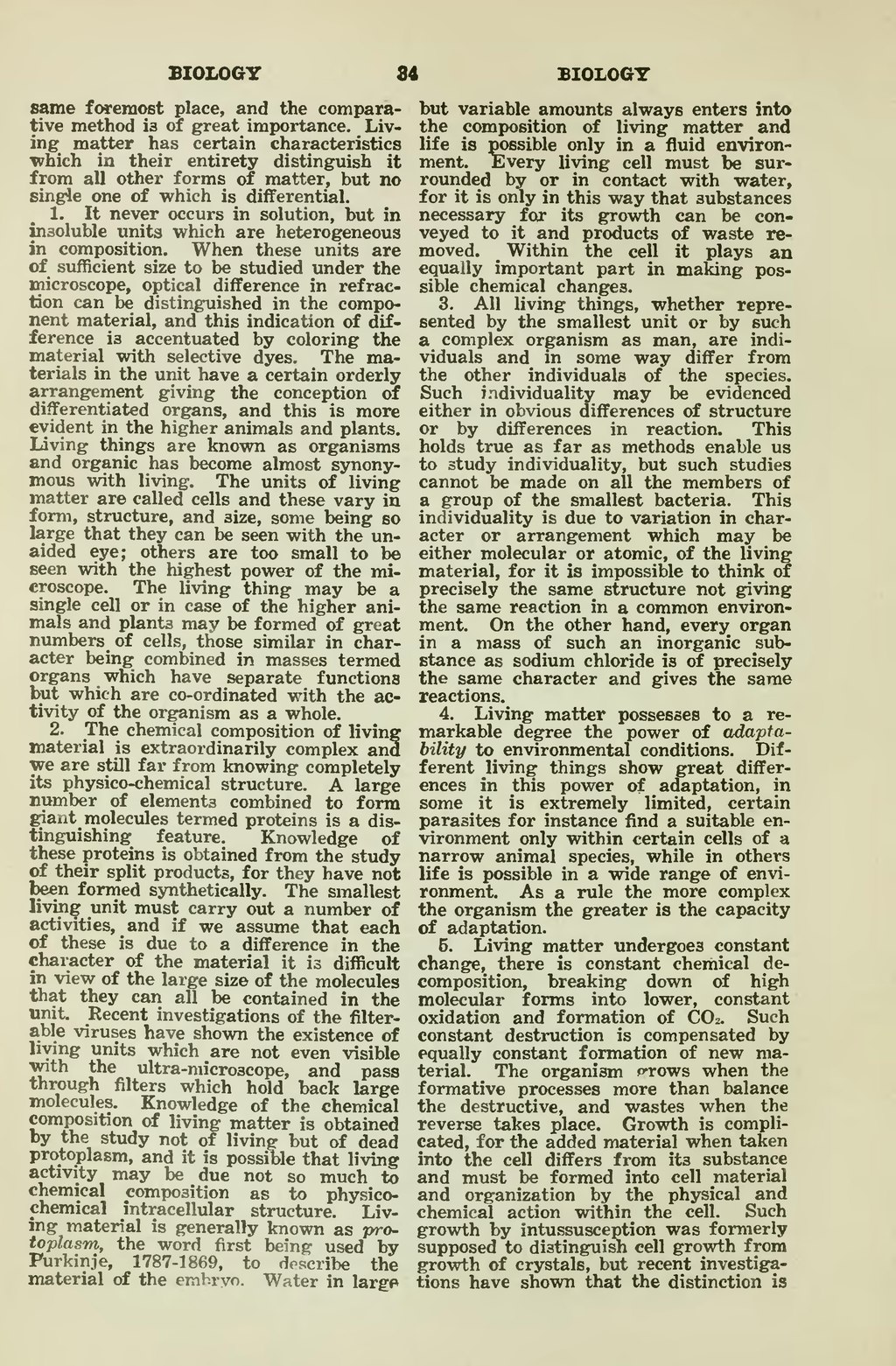BIOLOGY 84 BIOLOGY same foremost place, and the compara- tive method is of great importance. Liv- ing matter has certain characteristics •which in their entirety distinguish it from all other forms of matter, but no single one of which is differential. 1. It never occurs in solution, but in insoluble units which are heterogeneous in composition. When these units are of sufficient size to be studied under the microscope, optical difference in refrac- tion can be distinguished in the compo- nent material, and this indication of dif- ference is accentuated by coloring the material with selective dyes. The ma- terials in the unit have a certain orderly arrangement giving the conception of differentiated organs, and this is more evident in the higher animals and plants. Living things are known as organisms and organic has become almost synony- mous with living. The units of living matter are called cells and these vary in form, structure, and size, some being so large that they can be seen with the un- aided eye; others are too small to be seen with the highest power of the mi- croscope. The living thing may be a single cell or in case of the higher ani- mals and plants may be formed of great numbers^ of cells, those similar in char- acter being combined in masses termed organs which have separate functions but which are co-ordinated with the ac- tivity of the organism as a whole. 2. The chemical composition of living material is extraordinarily complex and yre are still far from knowing completely its physico-chemical structure. A large number of elements combined to form giant molecules termed proteins is a dis- tinguishing feature. Knowledge of these proteins is obtained from the study of their split products, for they have not been formed synthetically. The smallest living unit must carry out a number of activities, and if we assume that each of these is due to a difference in the character of the material it is difficult in view of the lai^ge size of the molecules that they can all be contained in the unit. Recent investigations of the filter- able viruses have sho-vm the existence of living units which are not even visible with the ultra-microscope, and pass through filters which hold back large molecules. Knowledge of the chemical composition of living matter is obtained by the study not of living but of dead protoplasm, and it is possible that living activity may be due not so much to chemical composition as to physico- chemical intracellular structure. Liv- ing material is generally known as jyro- toplasm, the word first being used by Purkinje, 1787-1869, to describe the material of the embryo. Water in large but variable amounts always enters into the composition of living matter and life is possible only in a fluid environ- ment. Every living cell must be sur- rounded by or in contact with water, for it is only in this way that substances necessary fox its growth can be con- veyed to it and products of waste re- moved. Within the cell it plays an equally important part in making pos- sible chemical changes. 3. All living things, whether repre- sented by the smallest unit or by such a complex organism as man, are indi- viduals and in some way differ from the other individuals of the species. Such individuality may be evidenced either in obvious differences of structure or by differences in reaction. This holds true as far as methods enable us to study individuality, but such studies cannot be made on all the members of a group of the smallest bacteria. This individuality is due to variation in char- acter or arrangement which may be either molecular or atomic, of the living material, for it is impossible to think of precisely the same structure not giving the same reaction in a common environ- ment. On the other hand, every organ in a mass of such an inorganic sub- stance as sodium chloride is of precisely the same character and gives the same reactions. 4. Living matter possesses to a re- markable degree the power of adapta- bility to environmental conditions. Dif- ferent living things show great differ- ences in this power of adaptation, in some it is extremely limited, certain parasites for instance find a suitable en- vironment only within certain cells of a narrow animal species, while in others life is possible in a wide range of envi- ronment. As a rule the more complex the organism the greater is the capacity of adaptation. 5. Living matter undergoes constant change, there is constant chemical de- composition, breaking down of high molecular forms into lower, constant oxidation and formation of CO2. Such constant destruction is compensated by equally constant formation of new ma- terial. The organism ptows when the formative processes more than balance the destructive, and wastes when the reverse takes place. Growth is compli- cated, for the added material when taken into the cell differs from its substance and must be formed into cell material and organization by the physical and chemical action within the cell. Such growth by intussusception was formerly supposed to distinguish cell growth from growth of crystals, but recent investiga- tions have shown that the distinction is
Page:Collier's New Encyclopedia v. 02.djvu/48
This page needs to be proofread.
LEFT
34
RIGHT
